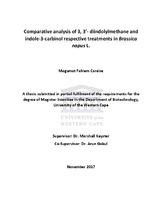| dc.description.abstract | Lately, there has been serious contamination of soils and ground water caused by mineral
mining and environmental pollution leading to heavy metal accumulation within soils and over
time rendering the soil infertile. The contaminated soil affects crop; yield, germination
percentage and leads to seed dormancy. Additionally, as plants are sessile organisms, exposure
to environmental stress involves different defense cycles and signalling molecules. Oxidative
stress, increases the production of reactive oxygen species (ROS) at greater rates than that of
the metabolism. Moreover, oxidative damage leads to the loss in cellular function and
eventually death. Nonetheless, plants have adapted ROS-scavenging systems driven by
reduction-oxidation reactions as defense mechanisms. In this way, cellular homeostasis is an
essential defending process and finding means to optimize these reactions would benefit in the
development of plants. Hence, environmentally friendly solutions are being reported such as
using glucosinolates, a secondary plant metabolite found in relatively high concentrations
within crucifers such as Brassica napus L. | |

